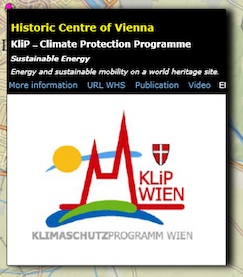Energy and sustainable mobility on a world heritage site.
 On the 18th December 2009 the city council of Vienna enacted the update of the climate protection programme of the city of Vienna (KLiP II), which will be valid until 2020. This programme is the update of the so called KLiP I, which was enacted 1999 and consists of 37 sets of measures with a total of 385 individual measures.
On the 18th December 2009 the city council of Vienna enacted the update of the climate protection programme of the city of Vienna (KLiP II), which will be valid until 2020. This programme is the update of the so called KLiP I, which was enacted 1999 and consists of 37 sets of measures with a total of 385 individual measures.
Reducing per-capita greenhouse gas emissions by 21 per cent by 2020 (baseline year: 1990) – this is the target of KliP II, the second phase of the City of Vienna’s Climate Protection Programme which takes climate protection policies forward through the decade 2010–2020.
This goal are to be reached by implementing energy efficient measures in several areas:
District heating and power generation: The ambitious goal is to raise the share of district heating to 50 percent through the further expansion of the district heating network of the municipal energy provider Wien Energie as well as improved efficiency and the use of renewable energies.
Housing: Continued funding for the thermal rehabilitation of existing buildings as well as tighter and higher insulation standards for new buildings are to help reduce heating demand.
Mobility: Vienna will promote measures and programmes to cut down traffic and reduce individual motorised traffic in favour of eco-mobility (the term denotes the combination of public transport, cycle and pedestrian traffic). Cycling is going to be a particularly important aspect in the future. Making pedestrian traffic more attractive will also contribute significantly to bringing down greenhouse gas emissions.
Renewable energy sources
The City of Vienna is pushing for increased use of renewable energy sources to replace fossil fuels. Projects realised to date include hydropower plants, wind farms, solar thermal plants, photovoltaic installations and a wood biomass power plant. As
there are constraints on the installation of renewable energy plants within the city limits, the City of Vienna is increasingly turning to new projects in the region, both within and outside the borders of Austria. Numerous forms of support are available for the use of renewable energy.
Changing energy sources
To bring down greenhouse gas emissions, coal and oil, but also electricity, should no longer be used to heat or cool buildings or provide warm water. The aim is to replace them with climate-friendly energy sources – primarily remote heat, but also renewable energy sources. In addition to taking action within its own administration, the City of Vienna also provides incentives in the form of subsidies and adopts relevant regulations to promote this shift.
Waste to energy
In 2010 Vienna was awarded the title “World City closest to sustainable Waste management”. It was conferred by the international waste management organisations WTERT (Waste-to-Energy Research and Technology Council) and SUR (Council for Sustainable Use of Resources) in recognition of Vienna’s efforts to put the idea of sustainability into effective practice and implement corresponding waste management strategies. Award criteria included data on waste production, recycling, composting and other waste-to-energy processes such as thermal treatment, fermentation and power generation from landfill gases.
Source: KLiP – The City of Vienna’s Climate Protection Programme – Measures and Reports
KliP Climate Protection Programme - PDF















